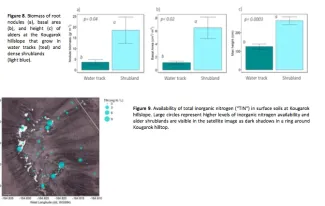Nitrogen limits the productivity of arctic plants so inputs of available N via symbiotic fixation have the potential to alter plant, soil and microbial interactions in these rapidly warming ecosystems. Alnus viridis (alder) is a deciduous shrub that forms a symbiotic relationship with Frankia bacteria. These bacteria fix atmospheric nitrogen (N) into biologically available forms within nodules formed on the shrub’s roots. To evaluate alder’s inclusion as novel plant functional type (PFT) in earth system models, we established vegetation plots across the six plant communities at the Kougarok hillslope on Alaska’s Seward Peninsula. Aboveground biomass, inorganic N and P availability in surface soils, and foliar %N and natural abundance δ15N were measured across all six plant communities. We quantified N inputs associated with alder by measuring N fixation rates using 15N-N2 and nodule biomass associated with tall stature alder individuals growing in alder shrublands communities. Nodule biomass associated with short stature alder growing in water tracks was also assessed. Although there was a high degree of variation in observed characteristics across the six plant communities, soil inorganic N availability and foliar %N were highest within plots located near alder shrublands, suggesting that symbiotic N fixation inputs from these communities impacts N availability of neighboring microsites. Variation in N inputs were driven primarily by variation in nodule biomass rather than by the observed rates of N fixation within root nodules. Nodule biomass for alder growing in shrublands was significantly higher than that of alder growing in water tracks (18.54 g/m2 vs 3.64 g/m2, p =0.04). Basal area of alder in shrublands was also higher (6.49 cm2/ m2 vs 1.14 cm2/ m2, p=0.02) as was height (264.5 cm vs 125 cm, p=0.0003). The dichotomous grouping of aboveground and belowground alder traits at this site suggests that an alder PFT could be parameterized with flexible, dynamic traits based upon these two different community types. Overall, our results show that the inclusion of a symbiotic N-fixing shrub in dynamic vegetation models will be crucial for capturing N cycling in these nutrient poor high latitude ecosystems.
For more information, please contact:
Verity Salmon
salmonvg@ornl.gov

